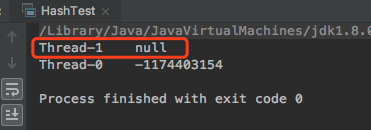多執行緒(九): HashTable、HashMap和ConcurrentHashMap
阿新 • • 發佈:2018-11-08
public class HashTest {
static Map<String, Integer> map = new HashMap<String, Integer>();
// static Map<String, Integer> map = new Hashtable<>();
public static void main(String[] args) {
for (int i = 0; i < 2; i++) {
new Thread(() -> {
int raddom = new HashMap
public class // 可以通過Collections將非線性安全轉為執行緒安全
Map<Object, Object> map = Collections.synchronizedMap(new HashMap<>());Hashtable
public class Hashtable<K,V> extends Dictionary<K,V> implements Map<K,V>, Cloneable, java.io.Serializable {
// 執行緒安全 同步方法synchronized
public synchronized V put(K key, V value);
// 執行緒安全 同步方法synchronized
public synchronized V get(Object key);
} 上面示例使用Hashtable就會每次都能獲取到資料

